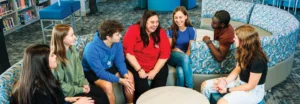
Traditional libraries are out — and media centers are in — as a reflection of how modern students learn today.
By Erika Gimbel. Erika Gimbel is a Chicago-based freelance writer who specializes in B2B technology innovation and educational technology.
This is not an old-fashioned library: In the Sebastian River High School Media Center, food and drink are allowed. So is chatting with friends and playing video games. The space is open and bright, with the school’s mascot shark emblazoned prominently throughout.
Officially opened in fall 2023, the new media center is a far cry from the old library space, which hadn’t been updated in 25 years.
“All the walls were painted pink. They used to call the school the pink prison,” laughs Kerri Wall, senior instructional technology administrator and data privacy compliance officer at the School District of Indian River County in Vero Beach, Fla.
And while the space may have been outdated, the bigger issue was that the old library did not fit with the school’s modern learning environment.
“We’re talking about a lot of books that weren’t even being checked out,” says Wall. “We really wanted to flip the script on what a media center space is.”
Like many school districts across the U.S., Indian River County has reimagined many of its learning spaces — from classrooms to former libraries — to keep pace with new technologies and the way students learn today.
An increasing body of research supports the conclusion that flexible learning spaces lead to better learning outcomes, including increased engagement with content and more positive interaction with peers.
“To prepare students for success in the 21st century, the ability to collaborate is essential,” says Patti Clark, chief academic officer at Lakeshore Learning Materials. “A trend I’m seeing everywhere is the transformation of school library spaces, which are becoming much more vibrant spaces for learning and collaborating, sometimes even developing into the hub of the school.”
Transforming traditional spaces takes planning, budget decisions and buy-in from school and community leaders. Here’s how a few schools took on the challenge.
DISCOVER: What does the modern library look like for K–12 students?
